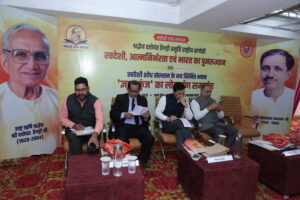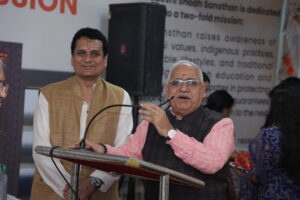Shradheya Dattopant Thengdi Commemorative National Seminar
Session 4 Report
Theme: Organizational path for Resurgence of Bharat
Date: Nov 9, 2025
Time: 04:30 pm
Venue: Gyan Kunj, New Delhi
Speakers: Dr. Sarabjeet & Researchers, Prof. Vikas Singh, Prof. Pradeep Ch. & Adv. Gagan, Sh. Satish ji
Incharge: Prof. Rajinder, Dr. Compesh
 The concluding session of the Shradheya Dattopant Thengdi Commemorative National Seminar encapsulated the day’s intellectual vigor under the theme Organizational Path for the Resurgence of Bharat. The session brought together scholars, administrators, and researchers to chart an actionable framework for institutionalizing Swadeshi ideals through collaborative networks, research programs, and organizational leadership. The proceedings were steered by session incharges Prof. Rajinder and Dr. Compesh.
The concluding session of the Shradheya Dattopant Thengdi Commemorative National Seminar encapsulated the day’s intellectual vigor under the theme Organizational Path for the Resurgence of Bharat. The session brought together scholars, administrators, and researchers to chart an actionable framework for institutionalizing Swadeshi ideals through collaborative networks, research programs, and organizational leadership. The proceedings were steered by session incharges Prof. Rajinder and Dr. Compesh.
The session began with an interactive discussion led by Sh. Satish ji, who delivered the Marga-Darshan address, offering both philosophical and practical perspectives on building a self-reliant and culturally confident Bharat. Subsequent presentations by Prof. Vikas Singh, Prof. Pradeep Ch., Adv. Gagan, and research scholars explored how the Swadeshi Shodh Sansthan (SSS) could evolve into a structured, multidisciplinary institution of thought and action.
Sh. Satish Ji: Vision and Organizational Framework
 In his address, Sh. Satish ji underscored the need for long-term institutional mechanisms to translate the philosophy of Swadeshi into transformative societal action. He clarified that the goal of the Sansthan is not policy lobbying, but vision building and public enlightenment rooted in indigenous wisdom. The emphasis, he noted, lies on research, field engagement, data analysis, and dialogue.
In his address, Sh. Satish ji underscored the need for long-term institutional mechanisms to translate the philosophy of Swadeshi into transformative societal action. He clarified that the goal of the Sansthan is not policy lobbying, but vision building and public enlightenment rooted in indigenous wisdom. The emphasis, he noted, lies on research, field engagement, data analysis, and dialogue.
Quoting from a book by Bhabhuti ji about China’s industrial model, he reminded participants of Thengdi ji’s prescient warning in 1992 against adopting the Western model of Liberalization, Privatization, and Globalization (LPG), and instead embracing Swadeshi as a comprehensive paradigm for national regeneration.
Satish ji emphasized that India’s current Total Fertility Rate (TFR) of less than 2.1 calls for a holistic strategy to balance population, productivity, and social welfare. He proposed that the Sansthan should advance entrepreneurship, not merely skill training or job creation, as this aligns with India’s traditional ethos of self-work (Swa-Karma) and independence.
He laid out a visionary goal to facilitate Swadeshi-centered research in over 1,200 universities across India, urging integration between academia, grassroots communities, and industries. Reiterating the institutional model proposed for the Swadeshi Shodh Sansthan, he outlined its organizational layers as follows:
- Top Management: Steering strategic direction and policy coherence.
- Advisory Board: Guiding research priorities and collaborations.
- Mentors: Divided across 12 verticals covering diverse areas such as economy, culture, technology, and education.
- Researchers: Conducting domain-specific and interdisciplinary studies.
- Interns: Serving as youth bridges to research and fieldwork.
This structure, he argued, would align intellectual pursuit with nation-building goals, ensuring continuity in vision and practice.
Prof. Vikas Singh: Collaborative Networks and MoUs
Prof. Vikas Singh elaborated on the growing organizational network of the Swadeshi Shodh Sansthan, highlighting recent achievements including the signing of 79 Memoranda of Understanding (MoUs) with academic and industrial institutions nationwide. These collaborations, he said, symbolize the shared mission of harnessing indigenous resources and talents for national resurgence.
Outlining the National Conversion Collaboration (NCC) model, he presented six systematic steps to strengthen institutional partnerships:
- Listing potential collaborators.
- Establishing contact and dialogue.
- Conducting meaningful conversations.
- Building sustainable relationships.
- Executing collaborative projects.
- Extending long-term institutional support.
Prof. Singh also emphasized the necessity of utilizing emerging technologies to enhance productivity, referring to experiences from MSME tool rooms and their flexible technological development models. Such networks, he suggested, could be crucial in fostering innovation and bridging the gap between ideas and implementation.
Prof. Nandini Sinha Kapoor: Harnessing Indian Knowledge Systems
The session also featured presentations on the Indian Knowledge System (IKS) program, with contributions by Prof. Nandini and associated researchers. She traced the establishment of the IKS Division under the Ministry of Education, Government of India, and the role of Swadeshi Shodh Sansthan in promoting its outreach. More than 2,100 scholars have enrolled in IKS-based courses aligned with UGC and JRF syllabi encompassing philosophy, architecture, geometry, and civil engineering.
Prof. Nandini highlighted the historical depth of India’s achievements in metallurgy, trade, architecture, and economic thought, reminding that before industrialization, India accounted for the world’s highest GDP share due to its ethical and knowledge-driven economy. She pointed out that preserving these traditional insights is vital for modern innovation and national confidence.
Prof. Pradeep Chauhan & Adv Gagan Kumar: Institutional Resources and Legal Framework
Prof. Pradeep Ch. and Adv. Gagan elaborated on the need for optimizing the institutional resources of Swadeshi Shodh Sansthan (SSS). They discussed the operational infrastructure, ongoing research projects, and future strategies for resource mobilization. They urged the expansion of digital platforms and inter-university interfaces to globalize Indian research perspectives while staying rooted in Swadeshi thought.
They also noted that SSS must play a bridging role, connecting academia, governance, and civil society. Adv. Gagan discussed the legal structuring, fund flow management, and compliance mechanisms needed to strengthen institutional operations. Both underscored that the Sansthan’s sustainability depends on transparent governance, collaboration, and youth participation.
Concluding Reflections
In the closing reflections, Sh. Satish ji reiterated that the resurgence of Bharat requires organized effort, moral conviction, and intellectual clarity. He encouraged researchers to blend spiritual insights with modern methodologies, ensuring that the Swadeshi initiative remains both visionary and pragmatic.
The session concluded with a collective understanding that Bharat’s resurgence is not merely an economic or political movement but a comprehensive cultural renaissance. Through the coordinated efforts of educators, researchers, industries, and communities, the Swadeshi Shodh Sansthan aims to become the institutional backbone of that resurgence—fulfilling Shradheya Dattopant Thengdi ji’s dream of an empowered, self-reliant, and spiritually enriched Bharat.






